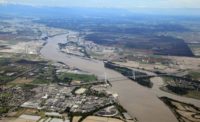Words Instead of Dollars

Henry Petroski, a professor of civil engineering and history at Duke, is the author of "The Road Taken: The History and Future of America's Infrastructure," which will be published in February by Bloomsbury.
Photo By Catherine Petroski
The idea that a poor U.S. infrastructure endangers the economy has a long history. Widespread awareness came in the early 1980s with the publication of “America in Ruins: Beyond the Public Works Pork
Barrel” by Pat Choate and Susan Walter. Issued first as a report from the Council of State Planning Agencies, it garnered little attention outside Washington
policy circles, but as the recession worsened, its message became front-page news in The New York Times and a cover story in both Time and Newsweek.
Although the report did not use the word “infrastructure” in its title and only used the term “public infrastructure” sparingly in its text, when it was reissued in book form, the report’s subtitle was changed to “The
Decaying Infrastructure.” Still the word remained obscure and unfamiliar to American readers into the late 1980s. For example, it did not appear in the title of the 1988 landmark report “Fragile Foundations: A Report on America’s Public Works” from the congressionally chartered National Council on Public Works Improvement. But the authors used the word in the opening paragraph of the report’s summary, which noted that U.S. infrastructure was “inadequate to sustain a stable and growing economy.”
In addition to its call for significant renewed investments to build on the accomplishments of the past, “Fragile Foundations” assigned a grade to each of eight infrastructure categories based on performance and capacity.
The report-card conceit lay dormant for a decade, until the American Society of Civil Engineers (ASCE) issued its first “Report Card for America’s Infrastructure” in 1998. The categories graded were basically the same as those in “Fragile Foundations,” with highways— given a C+ by ASCE—being subdivided into roads (D-) and bridges (C-). An added category, schools, received a failing grade. The average grade assigned was a D. The five-year investment need was estimated at $1.3 trillion.
The now quadrennially issued ASCE report cards have become a well-established institution, but the bottom-line grade has risen no higher than D+. And according to the 2013 report card, the needed investment had grown, at that time, to $3.6 trillion by 2020. It is not likely that kind of money will be forthcoming any time soon.
When the president’s fiscal-year 2016 federal budget proposal was released back in February, its cover emphasized infrastructure needs with a photo of New York’s aging Tappan Zee Bridge. While its
replacement is now well under
construction, the project’s financing has yet to be finalized.
But it is the numbers inside the budget proposal that tell an even sadder story. Of the almost $4-
trillion total request, $478 billion has been requested for transportation infrastructure—over six years. That figures out to about $80 billion a year, half of which is expected to come from federal fuel and other taxes and the rest from a new tax on foreign corporate earnings held overseas—a concept referred to as “repatriation.” Of course, Congress has yet to put in its two cents.
The $40-billion contribution from what is commonly referred to as the gasoline tax is surely an optimistic number, since, in recent years, this source of revenue for the Highway Trust Fund has been closer to $35 billion annually. And since Congress has virtually ruled out a tax increase, the fund likely will face continuing solvency problems until a long-term funding solution is found.
Almost three-dozen times in recent years, federal legislators have punted on this matter, offering short-term fixes as deadline after deadline has loomed. This situation has left state departments of transportation in a weak position to carry out long-range planning for major road and bridge projects. Another punt would come as no surprise.
As for the overall federal budget, when a shutdown of the government was imminent in late September, Congress voted for a continuing resolution to carry on government business at existing levels through Dec. 11—another short-term fix.
The word “infrastructure” has definitely become well established in our lexicon, more often than not modified by adjectives—“decaying,” “crumbling,” “failing”—by politicians seeking votes. But words come cheap; actions cost money. And in Washington, legislative actions to raise embarrassing report-card grades seem no closer now than they were decades ago.
Henry Petroski, a professor of civil engineering and history at Duke, is the author of “The Road Taken: The History and Future of America’s Infrastructure,” which will be published in February by Bloomsbury.
If you have an idea for a column, please contact Viewpoint Editor Richard Korman at kormanr@bnpmedia.com.




